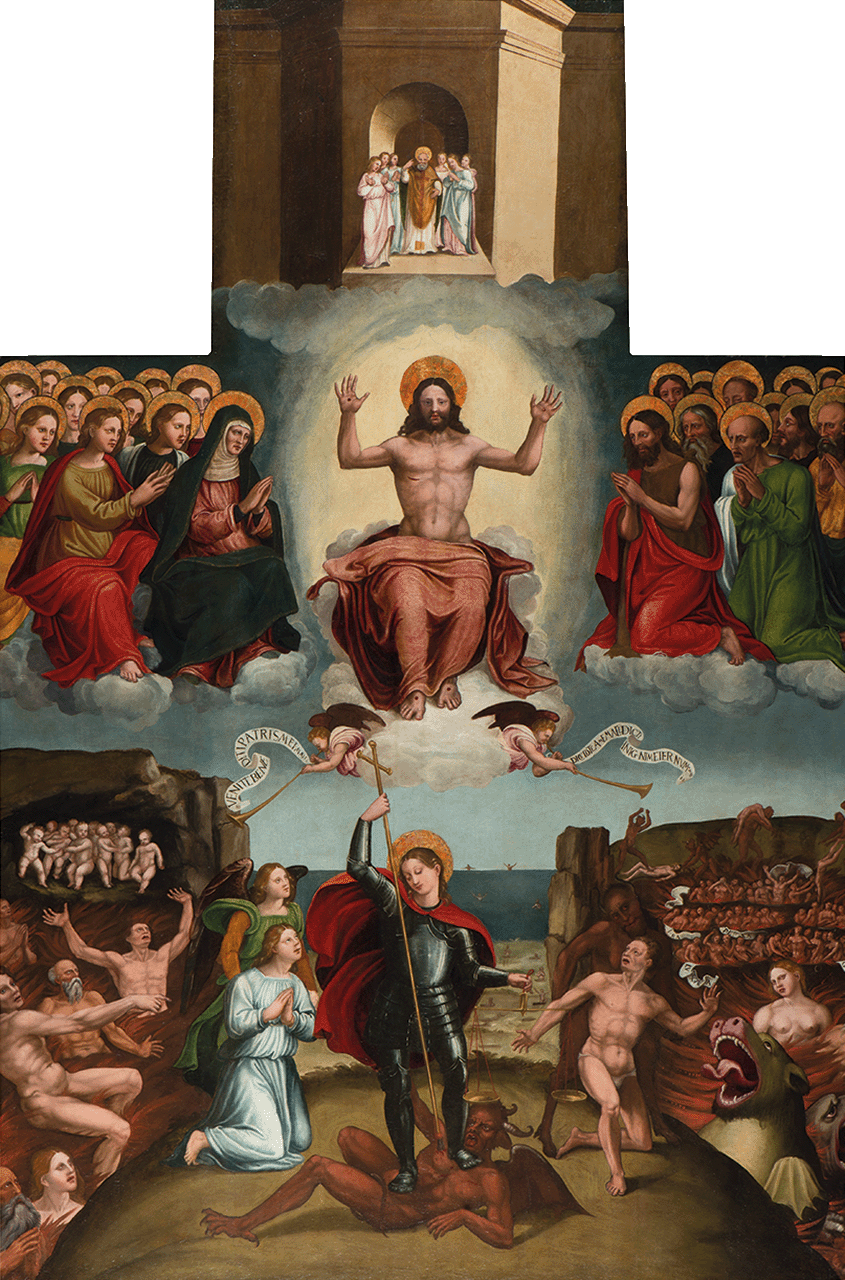
The Last Judgement with the Archangel Michael
The first striking feature of this panel is its unusual shape, which suggests that it was created either as a part of a larger altarpiece or to fit the narrow dimensions of a particular location. The artist has used the distinctive profile of the panel to present the narrative of the Last Judgement in three episodic tiers.
At the top, the entry into heaven is depicted as a city gate. St Peter, dressed in priestly robes, guards its doors. He is surrounded by a group of women waiting to enter, a reminder that Jesus gave Peter the keys to the kingdom of heaven (Matthew 16:19).
In the centre, Christ is seated on a throne of clouds. The artist has carefully rendered the anatomically accurate musculature of Christ’s body, suggesting qualities of perfection and divine strength. To his left, the Virgin Mary and St John the Evangelist lead a group of female saints, their hands joined together in prayer, while to his right, St John the Baptist leads a group of male saints and/or Old Testament figures, whose faces express differing emotions. Beneath Christ’s throne, two angels with trumpets announce the words ‘come ye blessed of my father’ (Matthew 25:34) and ‘depart from me you cursed into everlasting fire’ (Matthew 25:41).
The lower section focuses on St Michael, clad in armour and standing on the body of the Devil, who has been pierced with a spear. In his left hand he holds a scale in which to weigh the merits of individual souls. On the left of the scene an angel presents a young woman to Michael, while on the right, a naked young man, his face rigid with horror, is being dragged away by a cloven-hoofed devil. Behind Michael the landscape stretches to the sea, where bodies are rising out of both land and water in readiness for judgement. Hell is depicted by rings of fire, which are already consuming a number of anguished bodies. A group of children waits in a cave, reflecting the belief that the innocent remain in a state of limbo.
The theme of the Last Judgement and associated visions of heaven and hell have a long history in Christian art. Less common are compositions with Christ enthroned as judge with St Michael slaying the Devil directly below. The identity of the Master of Alzira was first proposed by Chandler Rathfon Post on the basis of an altarpiece painted for the Church of Saint Augustine in the Valencian village of Alzira. The altarpiece was dispersed as a result of the Spanish Civil War, but not before Post had established a small group of works that he believed to have been painted by the same hand. The Alzira Master could possibly have trained in the workshops of Fernando Yáñez de la Almedina (1459–1537) and Fernando Llanos (c. 1470–1525), who had both studied in Italy and introduced the style of Leonardo de Vinci to Spanish painting.
 Click to zoom and pan
Click to zoom and pan
...
Your feedback is very important to us. Would you like to tell us why?
We will never display your feedback on site - this information is used for research purposes.
Artwork Details
Title
The Last Judgement with the Archangel Michael.
Artist
The Master of Alzira (Valencia, active 1525–50).
Date
c. 1525–50.
Medium and Support
Oil on panel.
Dimensions
223 x 152 cm.
Marks and Inscriptions
None.
Acquisition Details
Jonathan Ruffer, acquired 2017.
Previous Owners
Unknown.
Institution
The Spanish Gallery, Bishop Auckland.
Bibliography
Chandler Rathfon Post, A History of Spanish Painting, XI: The Valencian School in the Early Renaissance, Harvard-Ratcliffe Fine Arts Series (Cambridge MA: Harvard University Press, 1953), pp. 175–362;
Hans Memling, ‘Last Judgement’, http://sadostateczny.mng.gda.pl/en [accessed: 25.07.22];
Miguel Ximénez, ‘Last Judgement’, http://ceres.mcu.es/pages/ResultSearch?txtSimpleSearch=Cristo%20Redentor&simpleSearch=0&hipertextSearch=1&search=simpleSelection&MuseumsSearch=MZ%7C&MuseumsRolSearch=3&listaMuseos=[Museo%20de%20Zaragoza] [accessed: 25.07.22]
